Our Racist Dogs
by Kelly Mays McDonald
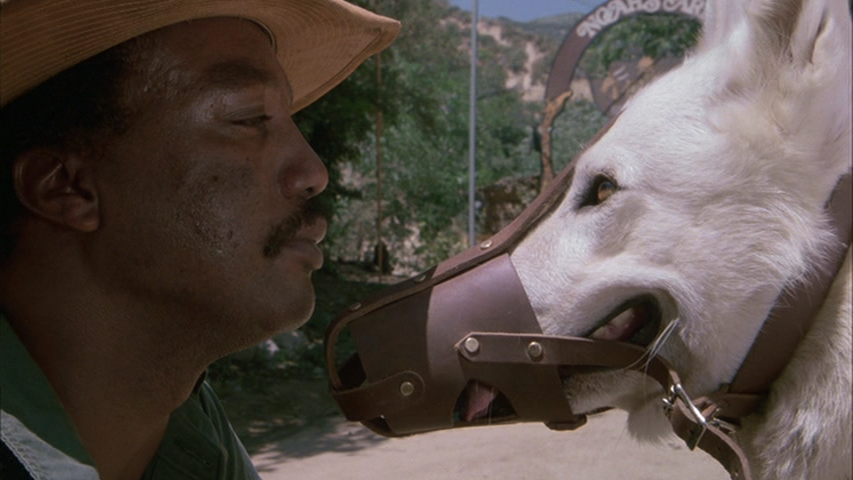
The first time I encountered the 1982 movie White Dog was on a lazy laundry-folding afternoon in 2012. I’m a weirdo who is completely obsessed with dogs, and I have a bad habit of searching for the word “dog” on Netflix and watching whatever absolute garbage turns up. I think last week’s pick was Snow Buddies, the second movie in the indomitable direct-to-video Air Bud spinoff franchise about talking holiday puppies. I’m not terribly selective with my laundry-folding films, as long as they feature a dog (especially many dogs), despite the fact that I make my living hanging out with dozens of cool shelter dogs every day. So I assumed that the film was schlocky German Shepherd Hero matinee fodder for 80s tweens — gee, a racist dog… who is literally a white dog?? lol — and pressed play.
White Dog, adapted from the autobiographical novel of the same name by French author Romain Gary, is the story of a diminutive white starlet named Julie who takes in a stray white German Shepherd dog, who — oops! — turns out to be violently racist. But she straight up denies that he might be a problem for society until he maims not one, but THREE people. Three. Finally, after she inexplicably brings her giant murderous dog on the set of a commercial job, he mauls her black costar, provoking Julie to take this shit a little more seriously. She refuses to give him a name so I will just have to refer to him as White Dog.
Dog trainers have a tendency to pan animal movies for being unrealistic. Cinematic liberties are easy to take when the results of a dog behavior rehabilitation program are often chalked up to a combination of animal whispering and magic. So on that basis alone I think I spent a good 90 percent of this movie laughing to myself. Additionally, the very notion of the White Dog was completely ridiculous. A dog that’s so virulently racist that he kills every black human being he sees? How does a dog even detect skin color? Can’t they only see the colors blue and yellow? If so, do I look blue or yellow? Sure, white people’s dogs have jumped at me a few times, but they never seem to be intent on ripping me apart. Does the movie conclude with the revelation that the dog is just a furry robot programmed by members of the KKK? Does the KKK put little dog-sized hoods on their robot dogs, or do they only make custom hoods for horses?
Julie visits the city pound after the dog goes missing (to kill a black truck driver in the film’s most Stephen King-esque murder, of which she is unaware).
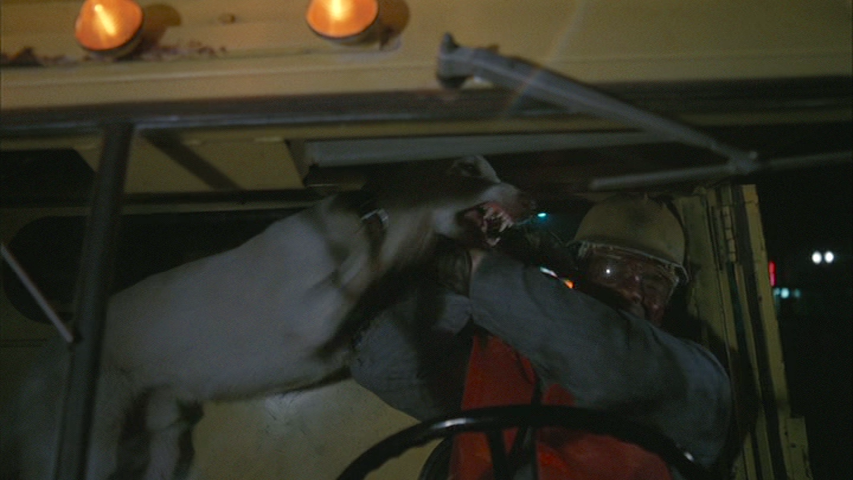
The shelter is brimming with poor defenseless pets waiting to be executed in an old-school gas chamber. She can’t possibly bear the idea of bringing her murderous, treacherous, gigantic dog to the shelter, or even to an actual dog trainer, so naturally she drives him to an exotic animal trainer deep in the Valley. Lo and behold, the white trainer Curruthers (played by a jocund Burl Ives teetering on the edge of senility) and his black assistant Keys (Paul Winfield, at his most strapping) happen to believe their life’s work lies in “curing” racist dogs, despite their primary focus of taming snakes and tigers for movies. Keys even volunteers to work for three weeks — day and night, without pay — to reprogram the dog with advanced training techniques such as:
- Yelling expletives from the other side of a fence while White Dog tries to bite him;
- Standing around in a full body bite suit while White Dog bites him;
- Eating hamburgers in front of White Dog;
- Lifting up his shirt to show White Dog his big brown tummy, which enrages White Dog, then rubbing his tummy to enrage White Dog even further, then giving him a hamburger for not biting the tummy;
- Waiting until White Dog is tired and then taking an afternoon nap together in a cloud of dust. White Dog is still mad, but also he is too sleepy to be racist.
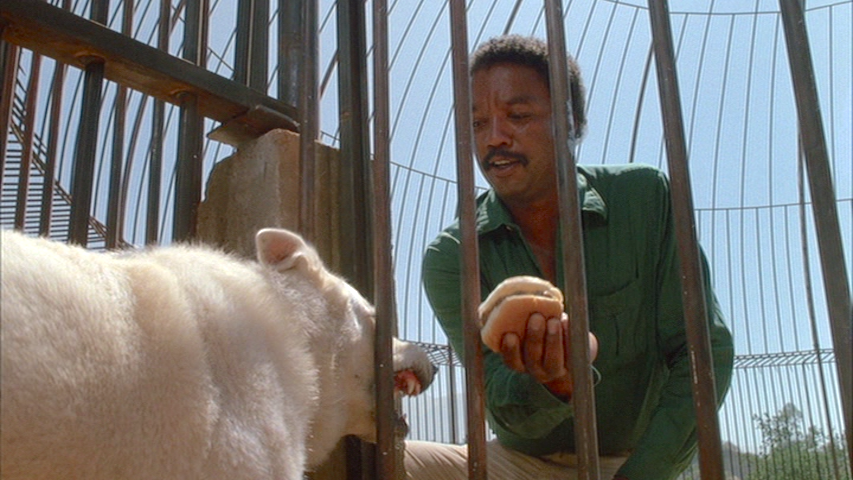
Progress is derailed for the next few weeks by Julie’s guilt-fueled coddling with secret bonus hamburgers (the dog is only supposed to eat from black hands, so this is a big no-no). Despite these exploits, Keys’ training seems to be wearing down White Dog’s resolve to bite the brown tummy. Meanwhile, Julie is approached at her doorstep by a hail-fellow-well-met white man accompanied by two little girls. “Please lady, can we have our dog back?” they lisp. The man claims that White Dog ran away from the trailer park, then boasts proudly that he trained the dog himself. Julie suddenly grows a backbone and barks back that the dog has been “CURED, BY A BLACK MAN!!!” before she righteously speeds away in a roadster to witness the final test of White Dog’s newfound sanity.
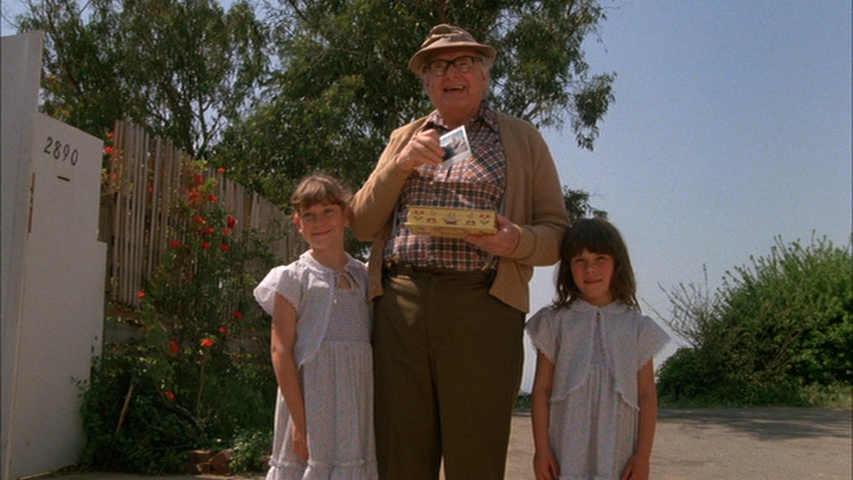
Needless to say I was a little baffled by this premise, and also a little distracted by my laundry, but something about White Dog got under my skin.

Two years later, I was working as an animal behavior assessor at a small shelter in the Midwest when I was again confronted with the concept of dog racism. Whenever a dog was aggressive to me during its assessment, the shelter manager dismissed it and opted to place the dog up for adoption. Inevitably the dog would bite someone, and I would be left scratching my head and wondering why my assessment was discredited. This went on for months before I finally confronted her. Why didn’t she believe me when I told her that a dog was aggressive?
“Oh,” she said, “a lot of dogs don’t like black people but they’re fine with everyone else.” With that she flipped her blonde ponytail and walked away. Was this just a workplace microaggression, or are these dogs actually racist? I found myself grappling with the idea that not only do actual humans hate me for being black; dogs could also hate me for reasons that are out of my control. I tried to fight her claims with deep academic research into animal cognition and ethology, immersing myself in texts and academic papers to unearth the potential for a dog to distinguish human beings by shades. I already knew that, for the most part, dogs bite people out of fear, generally solicited by underexposure or traumatic experiences. For example, I meet a lot of dogs who are afraid of people wearing hats. But dog discrimination in this context is less black and white than whether or not someone is wearing a hat. How dark would a person have to be for an undersocialized dog to feel triggered? Can dogs even distinguish people by color? Do I emit a smell detectable only to dogs that denotes my status as a human being worth biting?
Later, when I was working at an animal shelter in New York City, I was mauled during a routine walk with a 110-pound dog. The ten-minute attack was punctuated by the dog’s wagging tail, happy soft eyes, and what seemed to be a physical inability to detach his jaws from my leg. “He is having fun,” I thought to myself as I passed out. “He thinks this is a game.” In the ensuing months spent hospitalized and bedridden, dog experts in the field offered their reactions, which ranged from 99 percent blaming me for being attacked, to blaming me 110 percent for being attacked. Surely, they thought, a dog would never ever bite a person without provocation, much less maul them almost to death! But after revisiting the film during my lengthy recuperation process, it finally dawned on me that White Dog, like the dog who mauled me, was not a typical pet dog. He was a highly trained soldier.

Here lies the missing link in my initial dismissal of the film’s premise. In my ignorance as someone who works with pet dogs, I was considering aggression to be what it is in its most common state, which is fear-related reactivity stemming from poor socialization. I was correct in assuming that the pet dogs that I was encountering in Illinois were “racist,” projecting their owners’ choice to exist in a whites-only world, and perhaps even reflecting an inherent bias cultivated over decades of segregation. But I was missing the framework of a world of dogs beyond pets — a world made up of of what I call “weaponized” dogs — in which dogs are trained to violently target specific populations.
What is critically important about the origins of this dog, but is lost in the cinematic adaptation, is the fact that White Dog’s trainer is not an ordinary citizen, but a police dog trainer from Alabama. Director Sam Fuller clearly revised Romain Gary’s memoir to gloss over the fact that the titular dog’s violence is specifically related to state-sponsored police violence. In the book, the man who arrives at Gary’s doorstep to reclaim the dog is actually a former sheriff whose police officer son trained white dogs for two decades: “My son’s just retired from the police, after twenty years. He plans to go into business for himself. He wants to open a kennel. He’s a professional dog-trainer. Police dogs… I used to be a sheriff, myself.”
The sheriff, like the one depicted in the film, is completely unapologetic, even proud. When confronted by Gary with assertions that the dog is racist, he replies, “Yes, Sir, he’s a fine police dog… As good as they come. My boy trained him. He’s been training them for twenty years of his life, he’s a real professional… Fido has three generations of attack dogs behind him, all in the Police Canine Corps, all trained by my boy.”
This dog is one in a long line of Southern police dogs, trained to selectively kill and maim, originating from ancestors bred and trained by slave-catchers to hunt down errant human property: “Police dogs like [White Dog], I am told, almost all have generations of specially trained animals behind them. Both training and their inbred atavistic capital of push-button hatred are ‘improved,’ that is, facilitated by environment, with its automatic way of conditioning. Untrained dogs in black sections of the South will bark at whites just as in white neighborhoods they bark at blacks. Conditioning, training, and environment snowballed through generations until this ugliness becomes second nature.”
Weaponized dogs are ever-present in humanity’s long legacy of colonialism and slavery. They have fought alongside many instances of human atrocity to perpetrate acts of physical and psychological violence that supersede the scope of a simple gunshot. European colonizers of the New World notably trained their dogs to “relish Indian flesh” by explicitly feeding them the bodies of the victims after a battle. Throughout America’s early history, slave masters and bounty hunters adopted bloodhounds as the primary means of tracking down runaway slaves by scent, which is widely depicted in popular media. What is left out of the popular narrative, however, is the fact that when they encountered people on the run, the dogs were often trained to bite and tear the flesh of slaves to hold them there until they could be shot, shackled and dragged back to their masters for public lynchings and beatings.
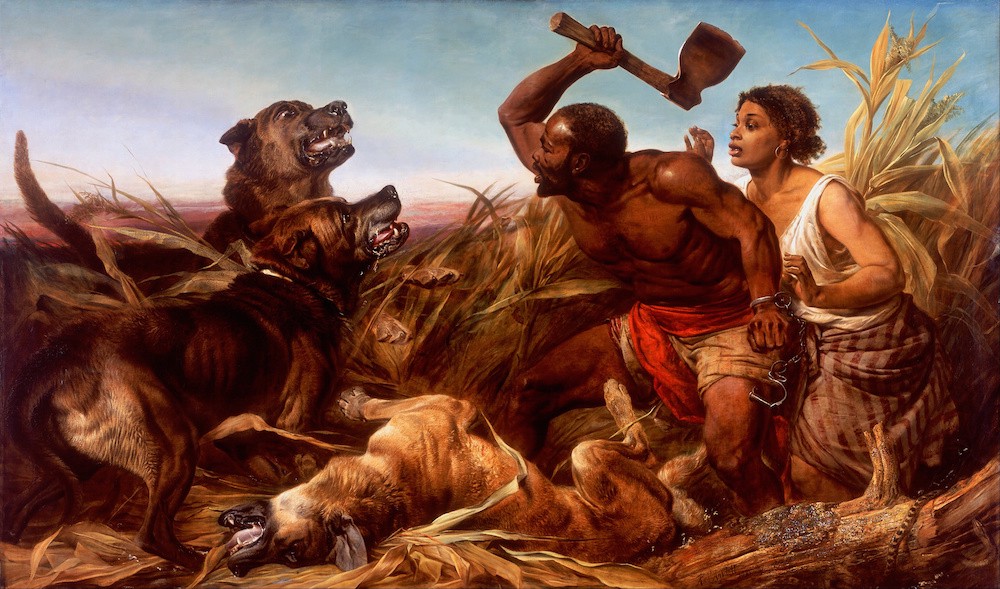
Ansdell, Richard. The Hunted Slaves. 1861. Oil on canvas. International Slavery Museum, Liverpool, England.
Mississippi Governor James K. Vardaman’s infamous Parchman Farm correctional work camp encouraged black inmates to violate its invisible fences in order to relish in the activity of hunting them down with ruthless bloodhounds. After decades of success in military work (most successfully by Germans during WWI), Shepherds were embraced by American police and military forces as a means of keeping specific populations under control with the threat (or more frequently, action) of maulings. Not much has changed in the past sixty years, since the famous use of police dogs to curb Civil Rights protests.
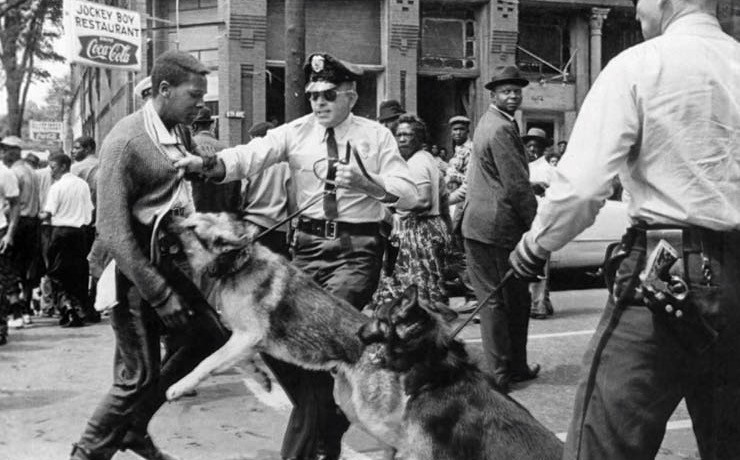
A 2013 independent review by the Police Assessment Resource Center revealed that 89 percent of people who were bitten by LAPD police dogs between 2004 and 2012 were black or Latino.
White Dog remains all too relevant, pointing to a distressing lack of progress in police dog training in the 34 years since the film’s inception. There do exist trainers such as Steve White, supervisor of the Seattle Police Canine Unit, who works tirelessly to establish standardization of sound training methods to ensure that dogs remain under control and “release” just as readily as they will bite. Despite his efforts, there is no established nationwide standard of police dog behavior, and their presence in our communities is still to be feared. Like the dog who mauled me, police dogs are brainwashed from an early age to have fun while they are “apprehending suspects,” and are often looking for an opportunity to play the “bite game” whenever their handler so much as hints at a command to attack. Popular opinion assumes that police dogs are trained to carefully follow a scent to ensure that they are catching the right Bad Guy. The reality of K9 pursuits could not be further from the truth. When there is a suspect in a general area, dogs are released by their handler to rove the area in search of whoever is in sight. When police dogs are triggered by running or quick movement, they hunt and take the trigger down with a technique called “bite and hold” until officers arrive to release the grip of its teeth from your leg, arm or neck — which is often difficult since the dogs enjoy biting so much.
Accidental discharge occurs on a regular basis, due to the trigger-happy nature of weaponized K9s and the lack of standardized training or management. In January, Norfolk, Virginia police released a K9 on a local college student for being too loud as she left a campus party; the dog tore apart her leg in several places before they were able to get him to release her. In Charlottesville, Virginia, a 13 year-old girl was maimed by a police dog who was accidentally let out of a car and ran to bite the first person he saw. Often, this hair-trigger training even leads to dogs maiming their own human handlers, like this K9 officer in Richmond, California. Sometimes police dogs who are cared for in the homes of officers attack members of their own family.
Weaponized dogs inhabit all levels of state-sponsored control, spanning from correctional dogs used to drag American inmates out of their cells, to the German Shepherds used by Ferguson police to intimidate black citizens on a regular basis. And although White Dog takes a lot of Hollywood liberties with the depiction of a former K9, we are still faced with the threat of bodily harm that can easily be dismissed as accidental. This form of police brutality, veiled in the guise of a dog’s intent, can serve to alleviate an officer from being held legally accountable for his or her own violence. Culpability is also diminished by the American public’s love affair with all things dog — although the dogs that we see in uniform are not pets, but weaponized animals encouraged from puppyhood to bite with force equivalent to being run over by a small automobile. And, like White Dog, they will continue to rehearse what they were taught until their archaic role in modern American police forces is put to sleep.
There are a handful of dispersed voices within academia and the legal system questioning the ethics and pragmatism of dogs working in a weaponized capacity. Some fairly high profile court cases questioning the viability of drug detection dogs as a tool of mass incarceration have led to a legal examination of whether or not drug detection dogs are acting upon racial bias from their handler, due to the Clever Hans Effect of unconscious cuing. But these voices are only blips in the sea of popular opinion, which extolls working dogs as selfless heroes. In the same vein, bite-and-hold dogs get a bit of a free pass because they’re often physically indistinguishable from dogs who are trained in unilaterally heroic pursuits, such as search and rescue or bomb detection. And although questioning police dogs in the courts and classrooms might lead to a broader conversation, we’re a very long way off from abolition.
So are White Dogs still a thing? Have weaponized dogs, after generations of intentional breeding as hegemonic tools, been threaded into the fabric of American dogs to the point where their own bias is inextinguishable? In the third act, Julie is jolted from her nonpartisan reverie when White Dog escapes the training facility and slaughters a black man on the altar of a church.

Unable to deny her culpability or the dog’s intentions any longer, her suggestion for euthanasia is decried by a dogged Keys:
Julie: He killed a man. In a church. And I’m sure it’s not the first black man he’s killed. Why didn’t you kill him?
Keys: I wanted to shoot him at the church.
J: Why didn’t you?
K: How I wanted to put a bullet in that son of a bitch!
J: Then why the hell didn’t you?
K: Because there’s still a chance to cure him.
J: Cure him? He just killed a man. There is no way you can cure that dog! I want you to shoot him now, before he kills more blacks!
K: So you finally joined the club. That club of horrified people who raise holy hell about that disease — that racist hate — but do absolutely nothing to stamp it out. That dog is the only weapon we have at least to remove a part of it! If I cure him.
J: If? “If” is not gonna stop him from killing people!
K: Yes, Julie. I can’t guarantee the result. But if I fail… I’ll get another white dog… and another, or another, or another, and another… and keep on working till I lick it. Because that’s the only way to stop sick people from breeding sick dogs. And goddamn it… I can’t experiment on a dead dog.
As a black American, I will continue to be tormented by the notion that I can somehow wield control over the oppressive system that I inhabit. Despite the innumerable generations of our nation’s stolen labor, stolen people, and stolen lands, the “if” is just too strong of a possibility to ignore. And so, while I know that I can’t rid the world of white dogs, I am driven to sacrifice my own sanity and safety to help change them.
Further reading: “You Should Give them Blacks to Eat”: Waging Inter-American Wars of Torture and Terror
